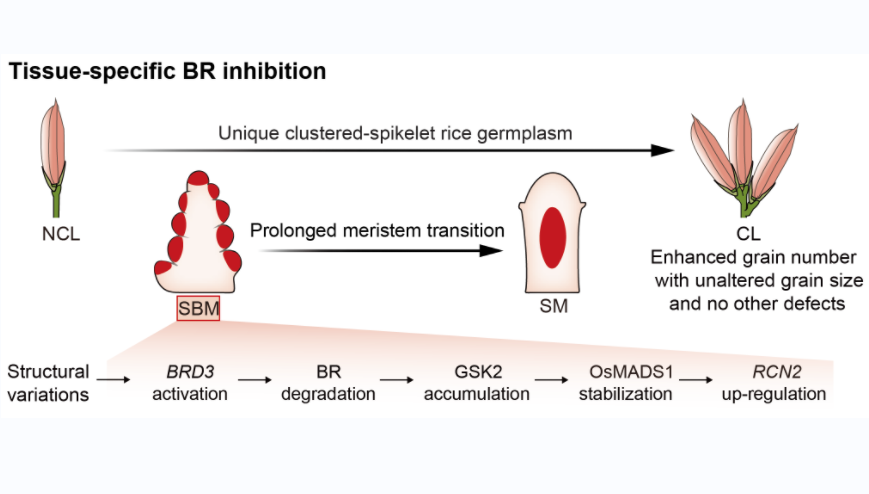Saturday, 11 October 2025
Chinese scientists decipher genetic code of double-grain rice
The research team conducted large-scale chemical mutagenesis on clustered-spikelet rice germplasm, creating about 10,000 clustered-spikelet rice muted lines, and studied their panicles one by one in the field Chinese scientists…

The research team conducted large-scale chemical mutagenesis on clustered-spikelet rice germplasm, creating about 10,000 clustered-spikelet rice muted lines, and studied their panicles one by one in the field
Chinese scientists have made a breakthrough in agricultural science by deciphering the genetic basis behind the formation of clustered-spikelet rice. This distinctive rice germplasm resource produces multiple grains from a single position, making it highly attractive for high-yield rice varieties. The study, published in the academic journal Science, was led by a research team at the Institute of Crop Sciences of the Chinese Academy of Agricultural Sciences, headed by Tong Hongning.
Since the 1930s, agricultural scientists worldwide have shown interest in clustered-spikelet rice, but the specific gene controlling the cluster formation of this type of rice has not been identified. To find the target gene, the research team conducted large-scale chemical mutagenesis on clustered-spikelet rice germplasm. They created about 10,000 clustered-spikelet rice mutated lines and studied their panicles one by one in the field.
After years of study, they discovered the mechanism behind how the plant hormone, brassinosteroids (BRs), regulates the number of grains per panicle in rice. Tong said, “Our research unveils a groundbreaking role of BRs in regulating panicle branching and grain number through precise meristem transitions. Therefore, manipulating BR distribution could provide effective breeding strategies for finely tuning crop traits, ultimately boosting crop yield.”
Field experiments showed that by regulating BRs, the yield of the clustered-spikelet rice can increase by 11.27 per cent to 20.96 per cent. Additionally, the team found consistent alterations in BR content in pepper and rose with clustered growth patterns, suggesting a broader role of BRs in controlling this phenotype in nature. Understanding the mechanism behind clustered-spikelet rice occurrence could offer new insights into BR function and its role in controlling similar growth patterns in various species, Tong added.
According to Lin Hongxuan, an academician at the Chinese Academy of Sciences (CAS), the cloning of related regulatory genes is difficult and has not been successful. Therefore, Tong’s team’s discovery is a significant breakthrough in rice research. Li Jiayang, another CAS academician, said this study provides a highly promising molecular design strategy that can help achieve high and stable crop production and ensure food security.
Technology
SodaStream breaks new ground with fruit Schorlen-Mix in SIG Dome carton bottles
Oct 10, 2025 | Company News
Inside Agilent’s Strategy to Make India Global Benchmark in Food Testing
Oct 10, 2025 | Food Safety and Testing
Nestlé and the World Farmers' Organisation partner to advance resilient food systems
Oct 09, 2025 | Company News
Food Testing
Inside Agilent’s Strategy to Make India Global Benchmark in Food Testing
Oct 10, 2025 | Food Safety and Testing
Arya.ag wins SmartAG Award 2025 for climate-resilient farming solutions
Oct 01, 2025 | Awards
Reducing Testing Time from 15 Days to 72 Hours: bioMérieux Leads the Way
Sep 19, 2025 | Food Safety and Testing
More Popular
Yakult Singapore introduces Y1000 probiotic drink
Oct 10, 2025 | Company News
SodaStream breaks new ground with fruit Schorlen-Mix in SIG Dome carton bottles
Oct 10, 2025 | Company News
PepsiCo names Steve Schmitt as CFO
Oct 10, 2025 | Beverages





